A fluid pressure transmission pill met several drilling challenges in an HPHT environment, including successfully balancing reservoir pressure.
Egil Ronæs, Ole Iacob Prebensen and Renate Mikalsen, MI Swaco; Knut Taugbøl, Svein Syltøy and Steinar Torvund, StatoilHydro
At Kvitebjørn Field, in the Norwegian sector of the North Sea, a Fluid Pressure Transmission Pill (FPTP) was developed for logging and completion operations in a Managed Pressure Drilling (MPD) situation. MPD operations have gained popularity for development of modern HPHT gas fields, yet batch drilling entire fields is a high-risk and high-cost approach. Due to rapid pressure drop commonly observed in many gas reservoirs after production initiates, the pressure regimes for drilling the remaining wells make the project more challenging. A cross-linked polymer pill was developed to isolate high-density drilling fluid in the well’s upper section from lighter fluid in the deeper section.
The FPTP, also known as a “mud-balanced pill,” fulfills several criteria, including use of only the circulating system to displace the pill. The test results show the pill remained entirely intact, and no remedial treatment was needed at surface. The FPTP serves as a contingency plan if necessary to open the choke and pull out of the hole without having to displace the entire well volume. The pill can transmit the hydrostatic pressure of the added high-density fluid above to the open hole below. Moreover, sufficient flexibility of the pill enables tripping, allows logs to be run and permits running of liners and production screen assemblies while preventing high-density fluid from channeling through it. The test results demonstrate a successfully developed FPTP for meeting these targets.
FPTP DEVELOPMENT
Development began in the laboratory using xanthan gum polymers cross-linked with a Cross-Linking Agent (CLA). Different combinations and concentrations of products were analyzed by running four stages of tests, each scaled up from the previous one, and using oscillating sweeps with a scientific rheometer to identify the ideal setting time and development of a gel structure in the cross-linked pill.
In the first phase, a 250-ml measuring cylinder was employed. In a later series, the cylinder was scaled up to a 2-m-long tubing with 5-cm ID. The tubing, set at an angle of 30°, was manufactured in clear plastic material and equipped with an analog manometer at its bottom to monitor pressure transmission through the pill.
The second test was performed at the University of Stavanger using a 4-m-long, clear plastic tubing with 19-cm ID, which was also set at a 30° angle. Different colored fluids were used to visualize placement of the FPTP and isolate high-density fluid in the upper part of the tubing.
The third test was set up at International Research Institute Stavanger (IRIS) on its R&D drilling rig Ullrig. The full-scale test’s goal was to prove the long-term stability of the FPTP by monitoring pressure changes at the bottom of the well over a 2-week period. A second target was exact monitoring of pressure variations while displacing in the heavy fluid on top of the FPTP. The third target was to monitor surge pressures while breaking circulation and running logging and completion tools through the pill.
The fourth and final stage of tests involved mixing and setting a cesium/potassium (Cs/K) fluid formate FPTP in the 9⅝-in. casing of Well 34/11-A-13 T2 in Kvitebjørn Field in Block 34/11, east of Gullfaks in the Norwegian North Sea, before drilling out the casing shoe.
Pill-setting formulations. Initial formulation was done by visually observing the pill’s setting time in lab cups in a heating oven at 40°C. Then, a steel pipe assisted in evaluating the integrity and flexibility of the cross-linked pill. A scientific rheometer characterized the gel strength of the cross-linked pill. This rheometer can be programed to measure gel structure development through oscillatory sweep measurements to avoid breaking the gels.
The initial work was performed with a Cs/K formate field mud of 1.87 Specific Gravity (SG) as a basis. For ensuing tests, the formulation was changed to clear brines to improve test repeatability. Polymers and clear Cs formate brine were mixed according to a set procedure to avoid variation in mixing times that might influence the pill’s setting time. Longer mixing time reduced the pill’s setting time. Brine and polymers were mixed for 5 min. before the CLA was added and mixed for an additional 2 min. A paddle mixer was used to delay the setting time until the pill could finally be placed. Various 1.87-SG pills were tested. The Cs/K mud was tested with various concentrations of xanthan gum and CLA. The formulation containing 17-g/L xanthan gum and 15 vol% CLA (17/15) set up rapidly to a very hard plug and remained intact after 5 days of static aging at 40°C.
The pills with 15/15 unit and 12/12 unit concentration also set up too quickly and were considered to be too firm when penetrated with the steel pipe. The pill with 10/10 concentration was used for subsequent testing, because this combination set up quickly and remained semi-hard after aging.
Scientific rheometer measurements. Drilling fluids professionals typically determine setting time by aging freshly mixed samples in heating cabinets at set temperatures and visually observing the setting over time. A rotational method, commonly used with thickening cement slurries, cannot be used because the motion breaks gels developed in a cross-linked polymer plug and prolongs setting time. In common practice, a consistometer is used for measurement in such a dynamic setting.
The scientific rheometer can be programed to determine static setting times by running oscillatory sweeps or amplitude sweeps. An amplitude sweep is an oscillatory test with variable amplitude (strain = 0.01%–100%) and constant angular frequency (v = 10 s-1). Amplitude sweeps are most commonly carried out to establish the limit of the Linear ViscoElastic (LVE) range. When performing oscillatory tests in the LVE range, the samples’ structural strength is not decreased during the whole test. The LVE range is when the storage modulus and loss modulus show a constant plateau.
In this test, a vane-type spindle eliminated slippage between a cylindrical bob and the sample. The temperature was set at 40°C, the expected temperature at the setting depth in the candidate well. The results are presented in torque plots, Figs. 1 and 2. The rheological measurements demonstrated variations in setting times with variable temperature and mixing time.
The FPTPs tested in Fig. 1 were mixed with 10 g/L xanthan gum and 10% CLA. The two curves met after 350-min. setting time when both reached a torque of 100µN-m, indicating that the ideal setting temperature is probably 40–50°C. At 60°C, the plug set up to a maximum measured torque of 200 µN-m in 70–80 min. and reached a rigidity that was too firm for the oscillating movements, leading to failure of cohesion between the plug and cup wall. The test also showed that the plug did not reach maximum gel strength at 30°C and should likely be re-formulated for low temperatures.
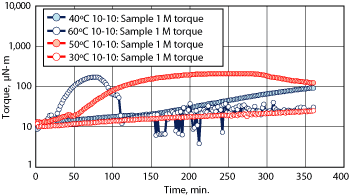 |
|
Fig. 1. Gel development at varying temperatures.
|
|
The FPTP set up in 1.5–2 hr at 40°C. The solid blue line in Fig. 2 shows gel development up to about 100 mN-m as expected. The sample where the gel development is demonstrated with a white/blue line (Fig. 2) was left to set in a cup before the gels were broken using a mixer; the FPTP failed to regain its initial gel strength. The graph demonstrates the need to displace the pill into the well within a limited time frame.
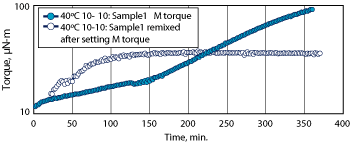 |
|
Fig. 2. Gel development and regaining initial gel after mixing.
|
|
A 250-ml measuring cylinder was initially used to set a cross-linked polymer pill in a 1.87-SG Cs/K formate field mud. The 2.08-SG Cs formate brine was displaced on top of the FPTP. The test looked positive initially, but after 1 hr the Cs formate brine had channeled through the FPTP.
The test was repeated at a larger scale, performed in a 2-m perspex tube with a 50-mm ID. The tube was set at an angle of 30° and filled up with 1.87-SG Cs formate fluid before a 1,000-ml FPTP with identical density was placed in and left to cross-link for 16 hr. After that time, a high-viscosity, 2.07-SG brine with 10-g/L xanthan gum was placed on top of the cross-linked pill, followed by 2.07-SG brine viscosified with 3-g/L xanthan gum, and pumped in to fill the remaining part of the tube. Different colors were added to the various phases to identify possible instabilities that might cause channeling through the pill.
Pressure changes while displacing in the high-density brines were monitored by an analog manometer in the tubing’s bottom. The pressure changes agreed with the calculated values and proved that the cross-linked pill transmitted pressures as expected for any liquid fluid column. The manometer also confirmed stability in the different phases when left static overnight. Subsequently, the practice of placing a high-viscosity brine as a cushion above the FPTP was implemented in all tests.
To simulate a liner being run through the cross-linked pill, a tube with a 2.4-cm OD (1.8-cm ID) was run to the bottom of the fluid column. The pill showed no indication of mixing or channeling between the different fluid phases. The tubing was later used to displace out the high-density fluid and the FPTP using a 1.87-SG Cs formate.
Experientially, moving from smaller-scale lab equipment glass tubes to larger tubes allowed easier handling of the equipment and showed viscosity contrast more apparently. Further live well testing involves more exact tools and reliance on a drillbit to evenly spread and set the highly viscous polymer. Therefore, the test format was scaled up for further testing.
Large-scale testing. The continued testing focused on placement of the pill and long-term stability while displacing in high-density brine.
A 4-m, clear plastic tube with a 190-mm ID was placed 30° from vertical. Pressure sensors provided digital signals to a computer from the bottom and from the middle of the tube to enable long-term monitoring of stability. An analog backup sensor was also installed at the bottom for pressure correlation.
The Cs formate fluid and FPTP were formulated at 1.87 SG. The FPTP used 10-g/L xanthan gum and 10% CLA according to experiences from earlier tests. The white-colored FPTP provided a good demonstration of the importance of using low flowrates and circular motion of the pipe to place the FPTP in the Cs formate fluid column, Fig. 3. The FPTP was left to cross-link for a minimum of 300 min. before a high-viscosity, 2.08-SG pill was displaced on top of the FPTP, and finally the 2.08-SG brine. The digital pressure transmitters failed to deliver data, but the registered pressure variations provided by the analog manometer agreed with the calculated pressures at various stages of displacement.
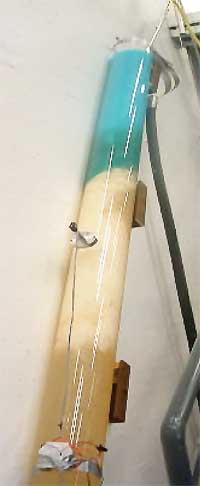 |
|
Fig. 3. Test setup in the large-scale plastic tubing showing the FPTP with 1.87-SG mud below and 2.07-SG mud above the pill.
|
|
Based on the observations during displacement of FPTP and high-viscosity fluids, it was recommended to use a “pull and pump” technique while rotating the pipe slowly in future full-scale tests.
Full-scale testing at an onshore well. The test was performed at IRIS on its R&D drilling rig. IRIS’s test well U-2 is a 6,585-ft cased hole with 9⅝-in. x 10¾-in. casing. The well builds angle up to 61.3° with an angle of about 13° in the area where the pill was planned to be set.
The objectives for the full-scale test were underscored by circumstances at StatoilHydro’s Well 34/11-A-13-T2 at Kvitebjørn Field. Downhole pressure data and the pill’s stability were key areas of focus to ensure full pressure transmission to the reservoir of the high-density fluid on top of the FPTP. Monitoring objectives included observing changes in general along with surge and swab effects while performing the following operations:
- Running logging tools through the pill
- Running a full-sized screen hanger assembly through the FPTP
- Circulating the pill out of the hole
- Gathering logging data to enable modeling of expected surge and swab effects in a future Kvitebjørn well.
Meanwhile, the plan was to run wireline logs and a full production screen assembly including a liner hanger through the FPTP. The FPTP’s long-term stability was established by setting an initial pill and leaving it for two weeks, performing a full displacement test, and finally setting a second pill with high-density brine above for the remaining test program.
RESULTS
The test results show that the mud pill met the criteria for well displacement, pumping, wire-line logging and running in with a liner hanger tool.
Well displacement and pumping. The well was displaced to Cs/K formate fluid with a density of 1.895 SG at 50°C. The volume was circulated until the properties stabilized, and pressure gauge sensors were run to monitor downhole pressure variations during the test. The FPTP was mixed based on earlier tests. A combination of 10-g/L xanthan gum concentration and 10% CLA was mixed in the slug pit. Density of the FPTP was 1.896 SG at 50°C. The cross-linked FPTP was set from 2,230 ft to 1,740 ft of MD. One-third of the volume was placed while rotating 30 rpm with a pump rate of 200 L/min. to avoid turbulence and subsequent mixing of the two phases.
The remaining part of the pill was pumped while pulling up to the final 1,740 ft of MD. Then, the FPTP cross-linked for 10 hr, after which the test commenced by displacing 25 bbl (4,000 L) of 2.075-SG Cs formate brine with 10-g/L xanthan gum. The high-viscosity, 2.075-SG pill was set from 1,740 to 1,490 ft using the same procedure as was used for the FPTP to avoid mixing of phases. The pipe was then pulled to the top of the 2.075-SG brine, after which the remaining annulus was displaced to the same density. Returns of heavy brine were received on surface at expected pump strokes, indicating that the cross-linked pill successfully isolated the lighter fluid below. Bottomhole pressure monitored by the gauge after displacement was 4,311 psi, which corresponded well with the wireline logs.
Wireline logging. Two wireline logging runs were made while the well was left static, to verify whether the FPTP isolated the high-density brine from the lighter brine below, and to record wireline tension. The tool’s weight dropped to 240 lb (110 kg) from 370 lb (170 kg) while running through the FPTP, and the weight was regained at a 2,280-ft MD, confirming the setting depth of the cross-linked pill. The second run, 6 days later, confirmed the first run’s pressure curve, Fig. 4. Pressure and temperature of the FPTP showed good stability over the full test period. The total pressure drop was 9 psi (0.6 bars), from 4,311 psi to 4,302 psi (297.3 bars to 296.6 bars), attributed to temperature effects or water contamination at surface.
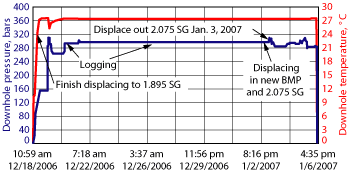 |
|
Fig. 4. Downhole pressure and temperature measurements during the FPTP test in the test well.
|
|
FPTP displacement and replacement. The FPTP pill was displaced out of the well after 15 days. As the well was re-entered, and after running in 1,740 ft, the gel structure was broken by rotating 30 rpm for 5 min., after which the well was displaced to 1.895-SG fluid. The pumps were started slowly to monitor the pressure required to break the gels. Maximum recorded downhole pressure while pumping was 4,500 psi; StandPipe Pressure (SPP) was 540 psi while pumping 110 strokes/min. (946 L/min). The maximum pressure increase recorded downhole while tripping in through the FPTP to 2,231 ft at a tripping speed of 130 s/stand was 58 psi.
The FPTP was then returned across shakers to attempt screening out cross-linked polymer. There was no visible increase in viscosity as the FPTP was returned to surface. The rheology of the FPTP as it returned to surface was low, indicating that most of the xanthan gum polymers were cross-linked and screened out by the solids-control system. Thus the FPTP could be incorporated into the 1.892-SG mud. Only minor interface between the FPTP and the high-viscosity, 2.075-SG brine was reported. A new FPTP was set from 2,260 ft to 1,770 ft using the same procedure as for the first pill.
Running in with liner hanger dummy tool. The well was displaced back to 1.896 SG. Rather than running a full production screen and liner hanger assembly, a liner hanger dummy tool was used. This tool was designed to expose the well to surge pressures such as those expected when running a completion screen with a hanger assembly through the 9⅝-in. casing. The OD was 8.425 in. at a length of 1.73 m. The tool’s total length was
15 m. The casing ID was 8.681 in., giving an effective clearance of 3.2 mm between the tool and the casing while running through the FPTP.
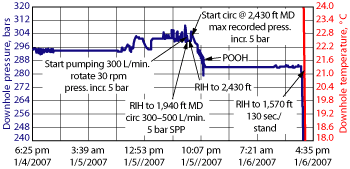 |
|
Fig. 5. Downhole pressure recorded when running the liner hanger dummy tool into the well.
|
|
Figure 5 shows the downhole conditions recorded while running in with the liner hanger dummy tool. Pressures were recorded using variable flowrates at different depths. The pressures seen in Fig. 5 corresponded with the following operations:
- At 1,570 ft while circulating with 2.075-SG fluid at 300 and 600 L/min., SPP varied between 61 and 117 psi (4.2–8.1 bars). Downhole pressure increase varied between 58 and 87 psi (4–6 bars).
- At 1,940 ft while circulating with 2.075-SG fluid at 300 and 600 L/min., SPP varied between 75 and 99 psi (5.2–6.8 bars). Downhole pressure increase varied between 58 and 102 psi (4–7 bars).
- At 1,570 ft while circulating with 1.89-SG fluid at 300 and 600 L/min., SPP varied between 73 and 86 psi (5.0–5.9 bars). Downhole pressure increase varied between 58 and 73 psi (4–5 bars).
The pressure increase while running through the FPTP was 58–87 psi (4–6 bars). The cross-linked pill was displaced out of the hole with a variable pump rate to avoid shaker overflow and to allow as much polymer as possible to be screened out by the rig’s solids-control system.
As a last qualification test, the FPTP should also be tested in the actual well at Kvitebjørn prior to drilling out of the 9⅝-in. casing.
Field testing. The test procedures from IRIS were copied offshore, setting the 9⅞-in. casing at Kvitebjørn Well 34/11-A-13 T2. At 5,000 L, a 1.83-SG cross-linked pill was set from 7,484 to 7,051 ft of MD after setting pressure gauges on bottom. At 8,000 L, high-viscosity, 2.06-SG brine was displaced on top of the FPTP, after which the remaining part of the well was displaced to 2.06-SG brine. The entire displacement was performed while maintaining a constant bottomhole pressure of 11,200 psi using the rig’s MPD equipment.
A drillpipe washout and subsequent loss of the entire bottomhole assembly took place after drilling 310 ft of new formation. A new cross-linked FPTP was set at a 6,230-ft MD, and the well above was displaced to 2.12-SG fluid to achieve an equivalent density of 1.92 SG on top of the reservoir. The FPTP enabled pulling out and a subsequent fishing operation to retrieve the lost BHA.
CONCLUSIONS
Tests concluded that use of a balanced mud pill based on cross-linked xanthan gum is a safe contingency procedure for controlling bottomhole pressure during MPD tripping in reservoir drilling operations. Pressure monitoring verified the pill’s stability over several weeks, even in 30° angled wells. FPTP allowed logging tools and liner hanger to be run through the pill without compromising its stability.
Furthermore, displacing out and breaking the pill’s gel structures were virtually problem-free. No fluids were lost in the solids-control systems, and the cross-linked polymers were screened out so fluid could be mixed back into the brine. 
ACKNOWLEDGEMENTS
This article was prepared from IADC/SPE 112528 presented at the IADC/SPE Drilling Conference held in Orlando, Fla., March 4–6, 2008.
|
THE AUTHORS
|
| |
Egil Ronæs earned his MSc and BSc degrees in marine engineering from the University of Bergen, located in Norway’s second-most populous city. Over the course of his career, his experience has ranged from mud logging for Sperry Sun Drilling to field service engineering and management at Schlumberger. More recently, Ronæs held several roles with MI Swaco in Norway before his current position as R&D Manager in Stavanger, Norway.
|
|
| |
Ole Iacob Prebensen has authored and presented many technical papers on the advancement of drilling fluid technology. At this time, he acts as Technology Manager at the MI Swaco’s European Technical Center. Prebensen is developing new drilling fluid technology for extended reach drilling, deepwater and HTHP wells.
|
|
| |
Renate Mikalsen is a Senior Lab Engineer at MI Swaco. He earned his BSc degree in chemical engineering at the University of Stavanger.Before joining MI Swaco, Mikalsen worked as a Project Engineer for Halliburton.
|
|
| |
Knut Taugbøl is Leading Advisor for Drilling Fluids at StatoilHydro. He earned his MSc in organic chemistry at the Norwegian University of Technology and his PhD in surface chemistry at the University of Bergen. Taugbøl has held numerous positions at MI Swaco. He also served as a Fluids Engineer at Saga Petroleum.
|
|
| |
Svein Syltøy graduated from the Norwegian Institute of Technology with a degree in petroleum engineering. Syltøy worked his way up starting as Drilling Engineer, then Lead Drilling Engineer, Drilling Supervisor and later Drilling Superintendent. He has experience with both floating units and fixed platforms. Syltøy was Drilling Superintendent with Kvitebjørn HPHT/MPD until it merged with StatoilHydro. Most recently at StatoilHydro, he was assigned to Algeria for land drilling operations in the Sahara Desert.
|
|
| |
Steinar Torvund held the position of Project Manager on the Kvitebjørn MPD project for StatoilHydro. He now serves as Chief Engineer for D&W facilities.
|
|
| |
|







